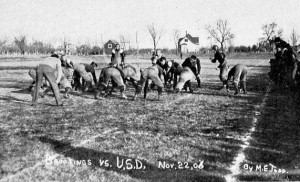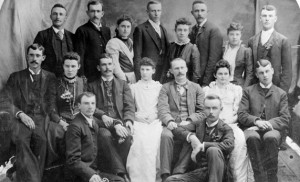Players took horses, wagons on two-day trip to Sioux Falls
At halftime at the game Nov. 17 pitting South Dakota State University against the University of South Dakota, it will have been, almost exactly to the hour, 123 years and five days since President Benjamin Harrison signed South Dakota on as the nation’s 40th state.

Each school's honor and right to gloat were on the line in a football game against the University of South Dakota in November 1906. Early contests were not fancy or complicated. With fewer than two hundred students at Brookings, any young man with ability had a chance to play.
Surprisingly, football teams from the two schools met for the first time six months before that signing.
That historic start of competition between the two schools was part of a two-day extravaganza in Sioux Falls in the spring of 1889. It also featured a track meet, a baseball game and an oratorical contest.
Pulling that all off wasn’t easy.
The last stagecoach out of Brookings had shuttered its canvas roll up windows a few years earlier. With the stagecoaches relegated to Western movie sets, the mode of travel for the players and spectators was horses and plain old sun-bleached wagons. It was a long trip with an overnight campout for the Jackrabbits in the Lone Tree area.
It took two days to get everyone to Sioux Falls, and two days to get everyone back to campus.
A former physics professor who became the popular dean of engineering, H. B. Mathews, for whom Mathews Hall is named, was on that Jackrabbit 1889 team.
In the Brookings Register, he left an interesting account of that game.
He played on the defensive line that was the “rush line,†except when the offense was near the goal line when they became the “goal defenders.â€

The graduating class of 1892 included Hubert B. Mathews (top row, third from right) and Albert S. Harding (middle row, far right). Both went on to long and distinguished careers as professors at the college. Mathews was part of the 1889 football team that played the first game against the University of South Dakota.
Footballs were bulky and less aerodynamic so passing wasn’t popular. In fact, the forward pass wasn’t allowed. Quarterbacks, or any ball carrier, could throw the ball to another member of the team, but only when that team member was behind the person carrying the ball.
Touchdowns were scored in a different manner than today. The runner had to get the ball over the goal line, of course, but he had to run the ball in between the goalposts that were planted right on the goal line. Extra-point kicks and field goals had to clear a frayed rope stretched between the posts.
During that first game, no coaches roamed the sidelines. “We never heard of such a person,†Mathews said of coaches. And back then, a field’s press box was probably a popcorn box thrown on the ground that a spectator had stepped on.
Uniforms were skimpy, with little or no padding. There were no helmets, thus no face guards.
Games in 1889 were halves of 45 minutes each. The final score of that first 90-minute game was 6 to 6.
Since touchdowns then were four points, and conversions were worth two, that’s probably how both the Coyotes and Jackrabbits put points on the board.
Prof. Mathews didn’t remember much about the other events of the day, except that Walt Cheever, a member of the 1889 State football team, ran the 100-yard dash in 10 seconds flat. He was the grandfather of Gene Cheever, who was a fast, shifty football halfback for the Jackrabbits in the early 1950s and also ran a 10-flat in the 100-yard dash as a track sprinter.








